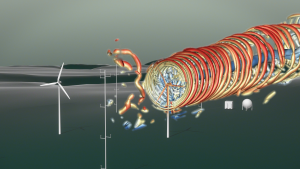The use of wind energy is increasing. More and more, mountainous terrains are opened up, where a regular wind flows and turbulences occur. Optimum operation of wind turbines at such places will be started by KIT and its partners on the WindForS research test field in the Swabian Jura. The WINSENT project is funded by the Federal Ministry for Economic Affairs and Energy and the Baden-Württemberg Ministry of Environment, Climate Protection and the Energy Sector with about EUR 11.6 million.
According to the Global Wind Energy Council, wind power plants generating some 63,000 Megawatts are installed every year. Around a fifth of this energy is generated in mountainous regions. However, installations on flat terrain are easier to operate than plants erected in complex terrain, where yield forecasts are more uncertain, wear and tear are greater, and maintenance costs are higher. The WindForS research cluster now aims at answering the question of how these systems’ performance can be optimized and their service life can be extended. The member of this research cluster is Karlsruhe Institute of Technology. In a team headed by the Center for Solar Energy and Hydrogen Research Baden-Württemberg (ZSW), wind energy experts plan a field test site in the Swabian Jura, at Stöttener Berg near Geislingen an der Steige, within the framework of the WINSENT project.
“Here, conditions are very complex from the meteorological and geological points of view and are very difficult to describe,” Professor Stefan Emeis explains, who coordinates KIT’s contribution to WINSENT. At the planned location, the prevailing westerly wind is accelerated over the upstream steep terrain step, which results in irregular flows and turbulences. Moreover, the area is characterized by a high average annual wind speed. These factors are typical of wind turbine locations in complex mountainous terrain and ideal for the development and testing of new technologies. The project “Wind Science and Engineering in Complex Terrain (WINSENT)” is aimed at setting up a test site to serve as a platform for research in industry. It is to be equipped with two wind turbines of around 750 kW nominal output, 75 m hub height, and 50 m rotor diameter each. One of the unique features of the project is that scientists will have unrestricted access to all control technology and engineering data of the turbines. During their construction, wind turbines will be equipped with measurement sensors from the foundation to the rotor blades. A 100-m tower will be installed in front of and behind each system to measure meteorological parameters, such as wind speed and direction, temperature, air humidity, and air pressure with high temporal resolution. State-of-the-art laser technology will serve to measure the wind power plants’ inflow and wake.
Research of the KIT scientists under WINSENT covers three aspects to describe the complex conditions on the test site. In cooperation with the WindForS partners, KIT’s Institute of Meteorology and Climate Research will measure and model local meteorological parameters. Instruments on the towers and laser-supported measurement instruments on the ground will determine the wind field. The data will be used to test and further develop numerical flow models that reflect wind and turbulence conditions on the test site, also between the measurement towers. KIT’s Institute of Soil Mechanics and Rock Mechanics will equip a foundation and its environment with sensors to measure forces and deformation and to refine computation models for the emission of vibrations or long-term stability on Karst underground. KIT’s Geophysical Institute plans to measure ground vibrations using seismometers installed in boreholes. In this way, vibrations will be determined as a function of wind speed and wind direction as well as of different types of soil and seasonally variable soil conditions, such as frost.
This will be the only wind energy test site with this equipment and in such complex terrain worldwide. The results of WINSENT will be scalable to large commercial plants and provide fresh momentum for industry with respect to e.g. quieter, lighter, and more powerful rotors. The project is also planned to cover accompanying ecological research. It will focus on the impact of the turbines on the animals and plants at Stöttener Berg. For interested citizens, a trail with display boards is planned on the terrain. The WINSENT grant No. 0324129A-F is funded by the Federal Ministry for Economic Affairs and Energy with about EUR 10.4 million. The project is scheduled for a duration of three and a half years. Another 1.2 million will be funded by the Baden-Württemberg Ministry of the Environment, Climate Protection and the Energy Sector. The Center for Solar Energy and Hydrogen Research Baden-Württemberg (ZSW) coordinates the ambitious project. Apart from Karlsruhe Institute of Technology, the project partners are Stuttgart University, Eberhard-Karls University of Tübingen, Technical University of Munich, and Esslingen University of Applied Sciences.
Press release of ZSW:
https://www.zsw-bw.de/nc/presse/presseinformationen.html
Video on the planned test site:
www.windfors.de/testfeld.html (in German only)
Being “The Research University in the Helmholtz Association”, KIT creates and imparts knowledge for the society and the environment. It is the objective to make significant contributions to the global challenges in the fields of energy, mobility, and information. For this, about 10,000 employees cooperate in a broad range of disciplines in natural sciences, engineering sciences, economics, and the humanities and social sciences. KIT prepares its 22,800 students for responsible tasks in society, industry, and science by offering research-based study programs. Innovation efforts at KIT build a bridge between important scientific findings and their application for the benefit of society, economic prosperity, and the preservation of our natural basis of life. KIT is one of the German universities of excellence.

